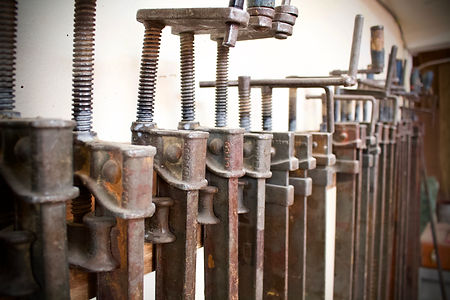
ABOUT US
WHO WE ARE
WHAT WE DO: THE SUBTLE NUANCES
In 1974 Nick Bruford began his apprenticeship under the tutelage of his father in-law and Swiss master craftsman, Andre Liardet. Four decades later, the work on Artisans du Bois is an ongoing tribute to the timeless European design, structure, and functionality.
Under Bruford's direction, Artisans du Bois follows the classic tradition of the French menuisier and ebeniste, creating old-world custom doors and projects and leave an indelible impression. With clients throughout the US and abroad, Artisans du Bois collaborates with discriminating homeowners, custom, builders, designers, and architects, accommodating requests that range from and entryway to an entire estate.
Although the firm works principally in French and Italian designs, it has extensive experience reproducing styles like Greene & Greene, English, Spanish, and Japanese. Nick Bruford custom designs most of his work, however, the inspiration behind many projects starts with photographs supplied by the client of designer.
At Artisans du Bois, modern technology complements the authentic old-world design and impeccable had finishing on which the firm built its reputation. Today, the firm delivers unprecedented precision in the architectural woodwork with computer aided design (CAD) and computer aided machining (CAM). Utilizing a five axis computer numerically controlled (CNC) router allows measurements accurate to the thousandth of an inch. These cutting-edge processes not only improve structural integrity, but also create shorter lead times and faster installations.
Joinery: When creating exceptional doors, quality starts below the surface. Mass production methods and cost constraints lead to most doors--even those in today's luxury homes--being produced with the structurally inferior methods. All of our door are constructed exclusively using mortise and tenon joinery, a method used for millennia and recognized for its superior strength and durability. The fundamental difference between our doors and others is simple: our doors are made to last multiple lifetimes. Similarly designed and constructed doors that are centuries old can be seen in Versailles, as made by master ebenistes employed by Louis XIV. This is the very reason that designers and architects will often pay top dollar for reclaimed 18th and 19th century doors imported from Europe.
Paneling: Panel matching adds significant aesthetic appeal to our doors. Panels are matched by selecting boards that complement each other in grain and color, and by using those same boards in every panel, from top to bottom. This provides a subtle, yet discernable continuity that catches the eye.
Hand Planing: With hand planing, less is more. Subtle hand planing adds another dimension to the texture and another layer of authenticity to our doors. Others may clumsily gouge their doors for an "antiqued" or "distressed" feel. However, the gentle hand planing on our doors is so nuanced, you may not even notice it until a ray of sunlight strikes it's surface. It's at such moments you'll feel the gratification of owning a world class door.
Finishing: Most of our doors have either an oil or lacquer finish, which is buffed with a French wax. Waxing is the final step of a nine part hand finishing process that brings out the full depth of the wood's grain. This finish on our doors will grow increasingly beautiful over time with minimal upkeep. For basic maintenance, we recommend applying every few years the same wav from France used in our finishing process.

